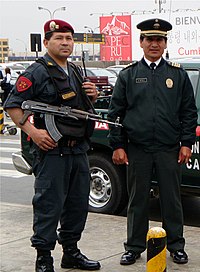Crime in Peru
| Peru | |
|---|---|
| Crime rates* (2017) | |
| Violent crimes | |
| Homicide | 7.8* |
| Property crimes | |
| Motor vehicle theft | 18,106 |
Notes *Number of reported crimes per 100,000 population. Source:INEI Statistical Yearbook of Crime and Citizen Security 2011–2017 | |
Crime in Peruhas steadily decreased since the 2010s and into the 2020s.[1]Peru's main indicators of crime are the homicide rate and the victimization rate; the victimization rate dropped from forty percent in 2011 to under twenty five percent in 2020.[1]
Crime by type[edit]
Murder[edit]

In 2012, Peru had a murder rate of 9.6 per 100,000 population.[2]There were a total of 100,000 murders in Peru in 2012.[2]By 2015, this had declined to 7.2-7.32[3][4]per 100,000, with 2,247 murders recorded.[3]
Corruption[edit]
Peru's most prominent political corruption scandal is probably the case ofAlberto Fujimori,Peru's ex-President. Fujimori has been convicted of having ordered killings, embezzlement of public funds, abuse of power and corruption during his 10 years of presidency (1990–2000). In 2006, Fujimori fled to Japan with an alleged USD 600 million of public assets. He has been sentenced to a total of more than 30 years in prison.[5]
Domestic violence[edit]
In 2006, Ministry of Women and Social Development (MIMDES) centers reported 25,036 cases of domestic violence in Peru.[6]The centers helped an average of 2,067 men and women per month.[6]MIMDES also operated atoll-free hot line,which handled 7,785 requests for assistance regarding family disturbances during 2006.[6]
Women's organizations noted thatalcohol abuseand traditional attitudes toward women aggravated the problems of rape andsexual abuse,particularly in rural areas.[6]In November 2006, theWorld Health Organizationreported that 69 percent of Peruvian women said they had suffered from some form of physical violence in their lives.[6]
A 2013 study byUniversity of San Martín de Porresfound that violence against women cost per $6.7 billion USD annually due to the loss of productivity.[7]
Illegal drug trade[edit]
The illegal drug trade in Peru includes the growing of coca and the shipment ofcocaineto the United States. In 2013, theUnited Nationsreported that Peru had become the largest producer ofcocainein the world.[8]
Illegal logging[edit]
Law and justice system[edit]
TheMinistry of the Interioris the main interior authority within Peru, overseeing thePeruvian National Police.The Judicial Power of Peru oversees thejudiciary of Peru,with theSuperior Courts of Justice of Peruassuming the role of trying criminal cases. TheInstituto Nacional Penitenciariois the government authority tasked with theincarcerationof criminals within the country.
References[edit]
- ^ab"Candidatos presidenciales dieron datos falsos sobre la pandemia y otros temas políticos en tercer debate del JNE".Ojo Público(in Spanish). 1 April 2021.Archivedfrom the original on 1 April 2021.Retrieved4 April2021.
- ^abGlobal Study on Homicide.United Nations Office on Drugs and Crime,2013.
- ^abPerú: Anuario Estadístico de la Criminalidad y Seguridad Ciudadana 2011-2017(PDF)(in Spanish).INEI.2018. p. 177.
- ^"Country list | dataUNODC".dataunodc.un.org.Retrieved27 March2024.
- ^"Freedom in the World- Peru".Freedom House.Retrieved6 February2014.
- ^abcdeReport on Human Rights Practices 2006: Peru.United StatesBureau of Democracy, Human Rights, and Labor(6 March 2007).This article incorporates text from this source, which is in thepublic domain.
- ^"La violencia contra la mujer genera pérdidas de US$ 6.7 mil mlls. al año en el Perú | Economía | Gestion.pe".11 November 2014. Archived fromthe originalon 11 November 2014.Retrieved4 April2021.
- ^"4 Reasons Why Peru Became World's Top Cocaine Producer".InSight Crime.27 March 2017.Archivedfrom the original on 25 December 2017.Retrieved4 April2021.

